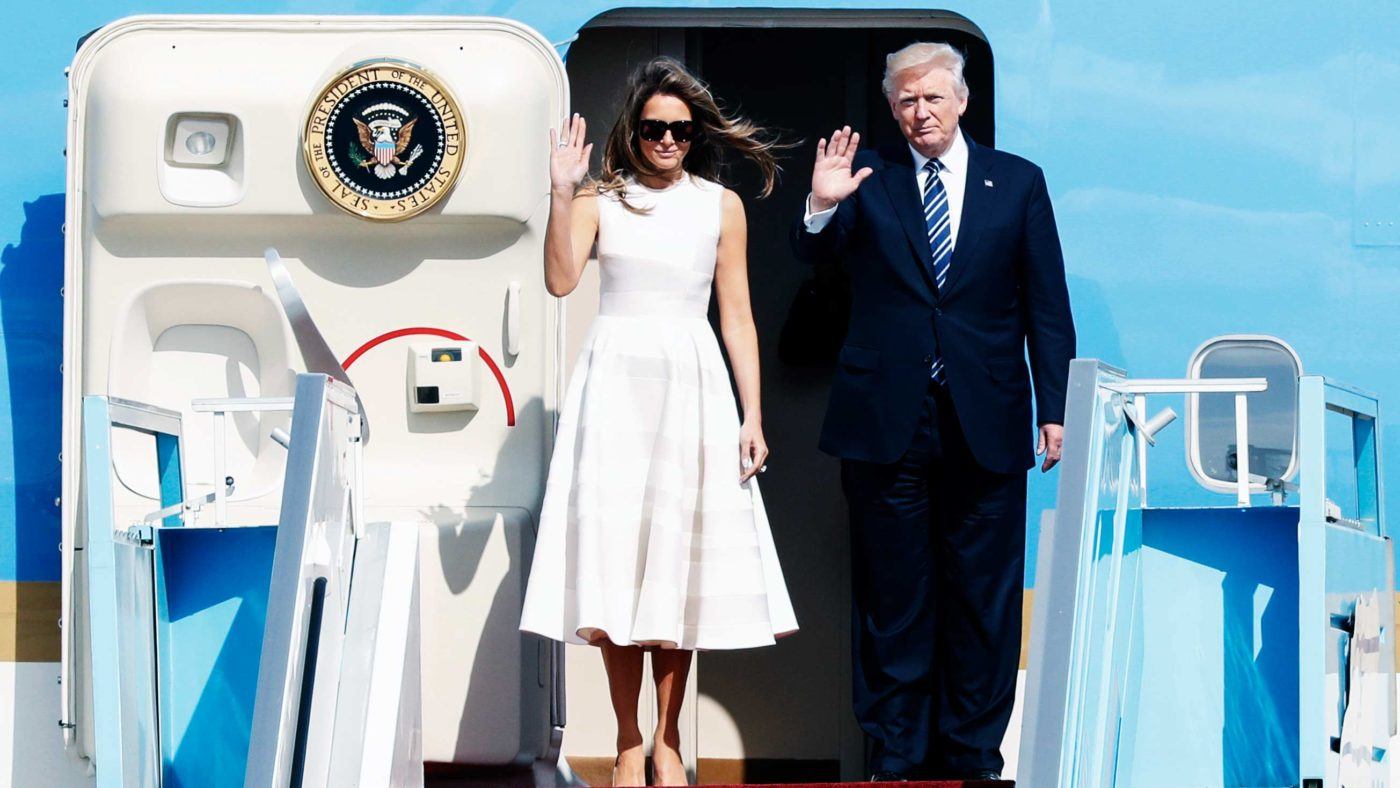In their second terms, American presidents take wing against their sea of domestic troubles. Turning to foreign policy, they retreat to the airborne safe room of Air Force One, with its gym, chef, and captive journalists, to ponder the intractable problems of the Middle East. For obvious reasons, Donald Trump has taken this course in his second hundred days.
Painful as it may be, we must admit that the Middle Eastern leg of President Trump’s first foreign trip was a success. Trump went from Riyadh to Jerusalem to Ramallah. He issued his platitudes in the right order. He avoided offending anyone.
Of course, back home his domestic troubles rumbled on—the American cable channels could not resist the visually arresting counterpoint between clips of Donald in Arabia with King Salman’s sons of the desert and footage of the President’s untrustworthy minions conspiring against him in Washington, DC. But the four-day tour of the snake pit went so smoothly that its most striking images were the ones in which the First Lady appeared not to want to hold his hand.
The hand-holding controversy neatly symbolised the domestic problems that Trump was getting away from, and the foreign problems that he was getting into. Had Trump’s people had the wrong kind of contact with the Russians? Given the collapse of America’s position in the Middle East under Barack Obama, the return of Russia to the region, and Iran’s advance towards the Mediterranean, whose hands will America be holding when the music stops and the shooting starts?
Trump’s itinerary gave us some idea; it spoke louder than the platitudes and with sufficient volume to indicate that his Middle East policy will reverse that of Barack Obama. On Monday morning, Air Force One flew from King Khalid Airport in Riyadh to Ben Gurion Airport near Tel Aviv. This was the first time an American president had flown directly from Saudi Arabia to Israel.
There has been some prior traffic on this most exclusive of routes. Its schedule of departures reflects the rise of Shiite Iran as a would-be hegemon. In 2007, George W. Bush’s Secretary of State Condoleeza Rice flew from Saudi Arabia to Israel, and in 2008, Bush flew from Israel to Saudi Arabia. But Barack Obama, pandering to the Saudi rejection of Israel’s existence, routed his itineraries accordingly.
Still, when Obama empowered Iran and legitimated the mullahs’ nuclear programme, he inadvertently attained the impossible dream of American diplomacy. He brought together the Saudis and the Israelis.
For several years, Benjamin Netanyahu has hinted at the top of his voice about the emerging alignment of interest between Israel and the Gulf Arabs, and the broader threat of Iran. Netanyahu has long advocated the “outside-in” approach to Israeli-Palestinian negotiations: folding an Israeli-Palestinian deal inside the Arab and Muslim acceptance of Israel’s existence. For their part, the Saudis were behind the Arab Peace Initiative of 2002, which offered a similar deal, albeit on terms amounting to the annulment of Israel’s Jewish majority.
Trump has yet to honour his pre-election promise to renegotiate Obama’s Iran deal. Still, he is switching back to America’s established alliances, and building up an anti-Iranian alignment of Israel and the Sunni Arabs. Obama had sin-binned Egypt’s president Abdel Fattah Sisi for overthrowing the government of Mohammed Morsi and the Muslim Brotherhood, and returning Egypt to martial law. But in early April, Trump received Sisi and then King Abdullah II of Jordan at the White House.
“I inherited a mess,” Trump said at his press conference with Abdullah. After this rare understatement, he reverted to hyperbole. “We’re going to fix it.”
Trump may be ignorant, but he is not an idiot. He is a deliberate vulgarian, skilled at identifying the lowest common denominator in every transaction, whether personal or financial. This is a bracing change from that clever fool Barack Obama, the inconstant patron who, abandoning old allies without making new ones, squandered America’s post-1973 dominance of the Middle East and invited Russia back into the region. But it does not mean that Trump will be any more successful at peacemaking than Clinton, Bush, or Obama.
As Trump found when his caravan reached Rome and the Vatican on Wednesday, you cannot be holier than the Pope. America cannot want an Israeli-Palestinian deal or an Israeli-Arab rapprochement more than the parties themselves do.
The Israelis and the Gulf Arabs want to contain Iran and arrest the region’s slide into chaos and slaughter. So does the Trump administration. If this pragmatic, stabilising alignment becomes an alliance, it will be for war, not peace—against Iran, not for the Palestinians.
Before his visit, Trump said that he liked the idea of doing the ultimate deal, but that he would not attempt it without the parties’ commitment. This week, the Israeli, Saudi and Palestinian leaderships made the usual pacific noises. But should serious peace negotiations develop, the Saudis will be hoist by the petard of their own fanaticism. The Israelis will find that their security needs cannot be reconciled with a Palestinian state on the West Bank. The Palestinians will take an opportunity to miss an opportunity.
This failure of jaw-jaw may strengthen the alignment for war-war. Trump cannot fix the mess of the Middle East, and is surely not so idealistic or foolish to think that he can. But he can repair America’s regional alliances. This, however, means confronting the insurgent power of Iran and the resurgent influence of Russia. Prematurely embattled at home, Trump may rapidly reach the terminus of foreign policy: a war in the desert graveyard of American presidencies.


